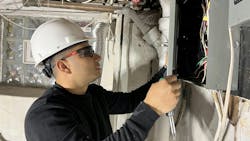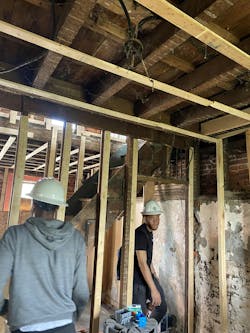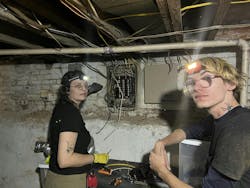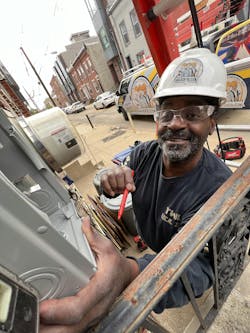What does a day in the life of an electrician actually look like? Given the fact that the broad EC&M audience works in so many vertical markets and industries, we thought it would be valuable to develop a series that showcases the different types of environments they work in, what types of electrical equipment they install, troubleshoot, or maintain, and what it takes as far as education and training to succeed in each field. This introductory article takes a closer look inside the wiring at what it takes to power America’s homes.
As the Director of Education and Training for the Leaders of Electrical License Preparation courses for Philadelphia and The Lehigh Valley and founder/director of The Academy of Industrial Arts (TAIA), a customized electrician training program that provides entry-level electrician training courses, electrical safety classes, and customized electrical construction courses, I have had a front-row seat over the years to determine what it takes to train all types (entry, intermediate, and master level) of electricians to go on and succeed in various industries/environments.
Residential electricians are the backbone of the construction industry. They ensure customers have power and lighting to meet all of their basic electrical needs at home. The typical pathway into the electrical trade for most electricians starts in residential wiring — the most basic and simplest form of circuitry in construction.
According to the Bureau of Labor Statistics, there were more 202,000 residential electricians currently employed in the United States in 2023. Of that total, only 3.3% were women, and the average age of a residential electrician was 41. These electrical professionals repair, install, and maintain equipment, such as receptacle outlets, ceiling fans, luminaires, circuit breakers, and panelboards. They also perform service calls when things stop working in a home, condo, or an apartment.
Predominantly serving a small, specific geographical area, town, borough, or city, residential electricians build a strong reputation in a community and usually work in that general area all year — travel to other states and geographical areas is not normal. They are also typically paid daily, hourly, or weekly.
Here are some examples of common service calls performed by residential electricians:
- Main service upgrade
- Panelboard changeout
- Installing recessed lighting
- Replacing failed circuit breakers
- Adding dedicated circuits for special appliances
- Troubleshooting old knob and tube wiring systems
- Replace or install smoke detectors or carbon monoxide detectors
- Installing outdoor lighting and receptacles for the holidays
These types of services are typically performed by medium-sized contractors (employing 25 to 100 electricians) or small mom-and-pop shops (often employing two to 24 electricians). Large electrical contractors routinely focus on commercial and industrial projects, which will be discussed later in this series.
One trick of the trade you’ll usually find among residential electricians is they get up early. They’re on the road before the rest of the workforce to prepare for the day ahead. Organized residential electricians prepare their materials before the job starts (e.g., painting mounting boards and “making up” service heads the night before). This saves hours of installation time on service upgrade jobs. Their workday typically begins at the “shop” to meet the “boss” and get material and assignments before “rolling out.” They often work in teams of two to three (although some work alone) with part-time helpers.
Apprentices often ride shotgun in the company vehicle with the owner, a journeyman electrician, or a lead technician.
Supply house runs are usually the first stop for smaller residential contractors. Large companies warehouse their own material inventory to save time and take advantage of bulk discounts offered by the distributor. Vans are stocked with everyday items electricians use on a regular basis (see the Sidebar “What’s in the Van?” below for a list of products typically found in a residential electrician’s service van).
“Old” work
There are two types of residential electricians: “old work” and “new work.” Old work electricians work in existing homes that may be currently occupied by residents or tenants. These homes or apartments have finished walls, ceilings, and flooring. Work in existing homes can be time-consuming and requires significant patience. Electrical problems are usually due to a bad or faulty single-pole or 3-way switch, which may take 30 minutes to diagnose and repair, or a defective or malfunctioning circuit breaker or fuse, which usually takes 45 minutes to diagnose and repair. Replacing the failed device or tightening a connection often fixes the problem.
A typical service call for residential electricians is for “non-working” receptacles, due to the overloading of an electrical circuit caused by portable heaters, air conditioners, or loose connections within the circuit. This problem requires more time to diagnose or repair if the home has older “knob and tube” wiring (a wiring system that dates back to the 1800s); it can take an hour or more to diagnose in some cases. The worst-case scenario is when it takes all day to trace a circuit throughout a house (sometimes cluttered or messy) to remedy or repair the problem. A common issue in a home with older wiring is broken neutral wires within the walls and improper backstabbing of wires at receptacles. This means using the push-in method to wire a duplex receptacle — and that’s a poor method to feed power downstream to other outlets.
“New” work
“New work” residential electricians are vital to builders during the early stages of a construction/building project; they provide the temporary power to the job site for lighting and tools that other trades need for the project’s duration. New construction electricians typically work on single-family homes or multi-family dwellings with exposed walls and ceilings. For a new electrical apprentice, residential new construction installations go much faster, fall on the simpler side, and are more manageable. Installing electrical systems in newly constructed buildings is often less complicated than working in existing buildings because electrical wiring is easily accessible during the construction phase of a home or apartment building.
Residential electricians rely on a basic set of hand tools (e.g., cutters, screwdrivers, and a hammer), a few power tools (e.g., drills and saws), and a strict adherence to the requirements in Chapter 2 (Wiring and Protection) of the National Electrical Code (NEC).
These Articles cover the “planning stage” of an electrical project and can take time to learn. For example, mastering the requirements for “dwelling units” can take a few years. They must also have basic and advanced knowledge of building materials. Electricians and apprentices should know what building materials are acceptable to secure, fasten, and support electrical equipment and devices, such as luminaires, ceiling fans, surface-mounted boxes, and other electrical equipment.
Selecting the appropriate bolts, fasteners, screws, supports, and fittings is essential. Choosing improper products or accessories can cause damage to the property or lead to equipment failure. For example, fasteners have weight limitations and are recommended for use with specific building materials like wood versus metal or concrete versus cement. Electricians also need to know time-tested methods for fastening electrical boxes and equipment on or within walls, ceilings, and building surfaces, such as plywood, concrete, drywall, or brick for installing electrical equipment.
Electrical material familiarity
Electricians need to know what materials are approved for specific uses such as receptacles and luminaires. For example, Sec. 410.10(A) of the NEC states: “Luminaires installed in wet or damp locations shall be installed such that water cannot enter or accumulate in wiring compartments, lamp holders, or other electrical parts. All luminaires installed in wet locations shall be marked ‘Suitable for Wet Locations.’ All luminaires installed in damp locations shall be marked ‘Suitable for Wet Locations’ or ‘Suitable for Damp Locations.’”
Receptacles are rated for “outdoor” wet location use versus “indoor” dry location use. Apprentices need to know the mechanical strength and durability of electrical materials (e.g., wire, receptacles, boxes, and connectors) to create reliable grounding and bonding connections throughout an electrical system. They need to know the acceptable use, selection, and suitability of electrical equipment, devices, panels, and fittings for specific purposes by the Authority Having Jurisdiction (AHJ).
Construction methods
Residential electricians should have a basic understanding of wood and light metal framing techniques for homes and apartments. Understanding the layout and location of other mechanical systems in the house or multi-family dwelling (e.g., plumbing, heating/air, existing electrical lines) comes in handy when “fishing” in new wires or modifying existing circuits and is beneficial to avoid damage to the property and existing wiring systems.
It’s also important that a residential electrician learn cost-effective methods of using materials efficiently and to shorten the construction or repair time, such as patching walls and ceilings, repairing bored holes in cement and concrete. Knowing the tolerances of lumber and joists before cutting or altering them for electrical installations is crucial. An understanding of the difference between load-bearing and non-load bearing walls is also essential.
Working hours
The number of service calls that a team of two electricians may respond to daily can range from one to five jobs per 8-hour day. A service call with the highest level of difficulty can take up to a full 8-hour working day, while the shortest time required to complete a service call could be only 30 to 45 minutes.
At larger shops, residential electricians typically work 40 hours per week Monday through Friday — weekends and overtime are usually optional. Electricians and apprentices from smaller mom-and-pop shops, however, work later and on some weekends; a typical day could start at 7 a.m. and end around 9 p.m., to keep up with service calls and the pace of construction. During the warmer “summer” months (peak season), a 60-hour work is typical at smaller residential contractors; it slows down during the colder months. Home renovations for kitchens, bathrooms, and additions peak during the warmer months; the option to work overtime and weekends at smaller shops typically runs throughout the entire summer, when demand is this high.
Education and training
In general, electricians have very little educational debt, if any. A lot of residential electricians learn in the field from “seasoned” experienced electricians while on the job. Others may learn the skill through a local trade school or college by completing a certificate or diploma program. These are short programs that typically run for six months full time (just a few nights a week) or part-time for about nine months (one night a week). The costs for “electrical technician programs” or residential “wireman” programs range from $2,000 to $9,000. The curriculum for these programs includes electrical theory; basic electrical safety; residential blueprint reading; residential electrical calculations; residential equipment and material selection; and residential and multi-family service equipment selection and sizing.
The exams required to pass these programs are usually created by the course instructor or from a nationally recognized curriculum approved by the state with an “intermediate level” of difficulty to pass, including basic math (e.g., multiplication, division, addition) and a general understanding of the NEC and related formulas. Completing certificate and training programs is a great way to get started in the electrical industry and secure opportunities for job interviews at a local company — but make sure you get some field experience while you’re pursuing this certificate or diploma. Bosses like to see field experience coupled with education.
Pros and cons of residential work
What one person considers a con, another might see as a pro. It really depends on the individual. Many electricians embrace these aspects of their work, but here are some potential advantages/drawbacks that are commonly cited by residential electricians.
If you’re weighing the potential benefits of this career path, many residential electricians find the following aspects of the work rewarding:
- Favorable working conditions
- Optimistic job growth forecast
- Minimum travel required (usually)
- Short training programs available (nationally)
- Requires less training and continuing education requirements
- Abundant opportunities during peak season (warmer months)
While many electricians find the work fulfilling, it’s important to understand the potential challenges that come with the job. Following are some common drawbacks noted by residential electricians:
- Flat pay scale
- Physically demanding and sometimes dirty work
- Unconventional or inconsistent hours
- Weather exposure
- Highly cyclical (seasons affect demand and pace) of work and employment opportunities
- On-call or emergency work
- Risk of injury
Career advancement opportunities
There are abundant opportunities for residential electricians. According to ZipRecruiter, as of August 2025, the average hourly wage of a residential electrician in the United States was approximately $29.51. However, salaries obviously vary depending on experience level, location, and employer.
Experienced residential electricians can advance to roles such as team leaders or crew leads. Some may even transition into sales positions that offer commission-based salaries. Additionally, residential electricians can take on full-time maintenance roles at property management companies or work as project managers for developers in multi-family and single-family housing projects. Some eventually register into employee-sponsored, four-year apprenticeship programs that ultimately lead to future partnerships and entrepreneurial endeavors.
A residential electrician can be a strong and rewarding choice, especially for those seeking hands-on, stable work that are in high demand with long-term growth potential and competitive pay — not to mention a short training path with relatively low debt. For anyone looking for an active profession that blends technical skill with practical problem-solving skills, becoming a residential electrician just might be the job for you.
In the end, a day in the life of a residential electrician is about more than just wiring homes — it’s about problem-solving, precision, and building lasting connections within the community. As this essential role continues to evolve with new technologies and growing demand, residential electricians remain the foundation of the electrical trade, offering a rewarding career path with real-world impact.
What’s in the Van?
Following is a list of a few common essential tools/materials most residential electricians carry to the job site:
- Single-pole switches
- Single-gang toggle plates
- 15A duplex receptacles
- Plastic duplex cover plates
- 15A ground fault circuit interrupters
- 3-way switches
- Metal old work device boxes
- 4-inch round metal octagons
- PVC old work device boxes
- 100A service panels
- 200A service panels
- #2 AWG aluminum service entrance cable unarmored
- 4/0 aluminum service entrance cable unarmored
- Ceiling fan mounts with brackets
- Metal handy boxes
- Drop cloths
- Booties
- Face masks
- Vacuum cleaners
- Cement mix
- Drywall plaster patch
- 2- to 4-foot ladders
- 6- to 8-foot ladders
- 10- to 12- foot ladders
- 18- to 32-foot extension ladders
- #18 AWG copper thermostat wire
- #10 AWG NM copper wire
- #12 AWG NM copper wire
- #14 AWG NM wire
- Two-gang plastic toggle plates
- Three-gang metal toggle plates
- 4-inch by 4-inch square metal junction boxes 1900
- ½-inch NM wire connectors
- ½-inch metallic wire connectors
- ¾-inch metallic nm wire connectors
- Trash bags
- ½-inch PVC conduit
- 2-inch PVC conduit
- Single-pole circuit breakers
- Double-pole circuit breakers
- Smoke detectors
- Doorbell chime kits
- LEDs
About the Author
Harold De Loach
De Loach is the Director of Education and Training for the Leaders of Electrical License Preparation courses for Philadelphia and The Lehigh Valley (www.necprepclass.com). He is the founder and Director of The Academy of Industrial Arts L.L.C. (www.taia-school.com), a customized electrician training program that provides entry-level electrician training courses, electrical safety classes and customized electrical construction courses. He is trained by the National Center for Construction Education and Research (NCCER). He is a member of The National Society of Collegiate Scholars, the Independent Association of Electrical Inspectors, the Electrical Association of Philadelphia, and the Better Business Bureau.
His level of knowledge affords him to teach entry, intermediate, and master level electricians. Armed with more than 20 years of experience in the electrical, general construction, and real estate development industry, he offers his students and clients several unique skill sets. He has worked as the Head Craft Instructor and Assistant Director of Education at the Apprenticeship Training Center (affectionately known as The ABC School) in Harleysville Pennsylvania for Associated Builders and Contractors (The South-Eastern Pa. Chapter). Prior to Joining ABC, he directed a work-readiness (Re-Entry) Construction Technology program within The Philadelphia Prison System and as an Electrical Technician Program instructor at Kaplan Career Institute (Formerly Thompson institute) in Center City Philadelphia and Franklin Mills. He is available for consultation, private tutoring, speaking engagements, or strategic partnerships that can bolster the number of new electricians entering the industry.






